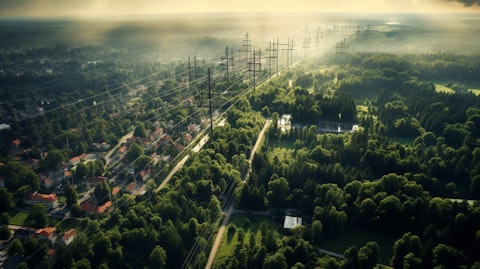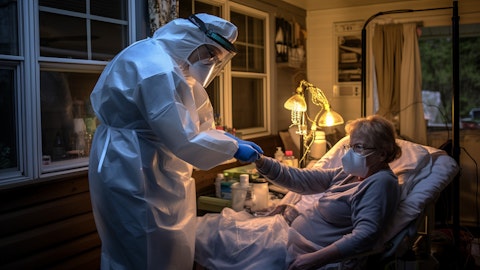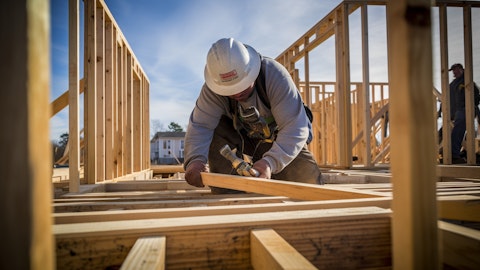Northwestern Energy Group Inc (NASDAQ:NWE) Q1 2025 Earnings Call Transcript April 30, 2025
Operator: Thank you for standing by. My name is Eric, and I will be your conference operator today. At this time, I would like to welcome everyone to the NorthWestern Energy First Quarter 2025 Financial Results Webinar. All lines have been placed on mute to prevent any background noise. After the speakers’ remarks, there will be a question-and-answer session [Operator Instructions] I would now to turn the call over to Travis Meyer. Please go ahead.
Travis Meyer: Thank you, Eric. Good afternoon, and thank you for joining NorthWestern Energy Group’s financial results webcast for the quarter ended March 31, 2025. My name is Travis Meyer, and I’m Director of Corporate Development and Investor Relations Officer for NorthWestern. Joining us on the call today are Brian Bird, President and Chief Executive Officer; and Crystal Lail, Chief Financial Officer. Brian and Crystal will be walking us through the results and providing a little more color on a very solid quarter. NorthWestern results have been released, and the release is available on our website at northwesternenergy.com. We also released our 10-Q premarket this morning. Please note that the company’s press release, this presentation, comments by presenters and responses to your questions may contain forward-looking statements.
As such, I’ll direct you to the disclosures contained in our SEC filings and the safe harbor provisions included on the second slide of this presentation. Also note that this presentation includes non-GAAP financial measures. Please see the non-GAAP disclosures, definitions and reconciliations included in the presentation. The webcast is being recorded. The archived replay will be available shortly after the event and remain active for 1 year. Please visit the Financial Results section of our website to access the replay. With that, I’ll hand it over to Brian Bird for his opening remarks.
Brian Bird: Thanks, Travis. The recent highlights for the quarter reported GAAP diluted EPS of $1.25 and non-GAAP diluted EPS of $1.22. We are affirming our long-term rate base and earnings per share growth rate targets of 4% to 6%. We’ve completed our debt financing needs for 2025. And again, we’ll stress, we have no planned equity to finance our current 5-year capital investment. From a dividend declaration standpoint, we declared a $0.66 per share payable June 30, 2025 dividend to shareholders of record as of June 13, 2025. The Montana rate review’s nearing completion. We have a full natural gas settlement reached with major intervenors and a partial electric settlement reached as well. And I think you know, the hearing starts on June 9.
And lastly, the Montana legislature has passed wildfire and other constructive bills now pending the governor’s approval. As we start presentation today, before we get into the quarterly results, just to remind folks of the value proposition for NorthWestern. Starting with a 5% dividend yield is very, very attractive, as you know. Add to that, a 4% to 6% EPS growth, great investment, as you know, in the next 5 years over — across our total business provides a 9% to 11% total growth profile. We do believe there are opportunities with data centers and new large load up opportunities to actually potentially achieve greater than 6% EPS growth. In addition to that, there’s FERC regional transmission, incremental generating capacity and transmission capacity associated with meeting new large load opportunities, which could result in greater than 11% total growth returns.
And with that, I am going to pass it over to Crystal to talk about the first quarter.
Crystal Lail: Thank you, Brian, and good afternoon, everyone. Thank you for joining us here in our update. In my comments today, I will cover a few things, updates since we last talked at our year end earnings call in February. As Brian highlighted, we’ve been busy. So it’s been a busy couple of months. So our first quarter 2025 results, I’ll give you more detail on those, also update you, and Brian mentioned a couple of our financing execution in the last couple of months, also providing a bit more additional insight into our key regulatory proceedings and update you on our 2025 outlook. We delivered a solid first quarter driven by strong margin contributions from both the electric and gas segments and ongoing consistent expense management.
Moving to slide 7. This details the drivers of our earnings per share compared to the same period last year. We reported earnings of $1.25 on a GAAP basis as compared to $1.06 in the first quarter of 2024. These higher earnings were driven by rate recovery and colder weather, offset by operating costs, depreciation and interest expense. Moving to slide 8 for a bit more detail on how the margins increased breakdown. New rates, both via interim rates and also final base rates, drove $0.20 of margin improvement, which reflects impact notably in all three of our jurisdictions. We also saw favorable loads of $0.13 during the first quarter here due to colder weather, customer growth and usage on our system. In addition, we continue to see favorable transition revenues of about $0.05 of contribution in the quarter.
I would also note that the PCCAM column here or the non-recoverable Montana electric supply costs, while that looks like a small variance for the quarter, when you think about total impact there, we had a Q1 detriment this year of $2.7 million. I almost said $27 million, which as many of you who follow us know, that’s what the total amount would be, the 10% sharing would be the $2.7 million impact of detriment this quarter. And this compared to $3 million of detriment in the prior quarter, so first quarter of 2024. So comparatively, only $300,000 of impact there is slightly favorable. But I would just highlight that we expect to see that as an ongoing trend here in 2025 of headwinds on the PCCAM front, again, cost being above that baseline.
And as I’ll get into in a little more detail that remains an open item in our Montana rate review. So again, including the earnings for the quarter on margin, significant improvement there on the back of rate recovery relief necessary to offset the costs that are already in place. Moving to slide 9. I highlighted already that weather was favorable during the quarter. So weather favorably impacted the first quarter by $0.03. While in the first quarter of 2024, we had milder weather. So it was unfavorable by $0.01. So that’s a $0.04 swing between first quarter of 2024 to first quarter of 2025. In addition, in the first quarter of 2024, there was net $0.02 of favorable adjustments that were backed out for other matters during the first quarter of 2024 that were onetime items.
So on an adjusted basis, you’ll see that our GAAP reported results for the quarter of $1.25, removing again favorable weather for the quarter of $0.03 to an adjusted earnings of $1.22, and that’s a $0.13 improvement over the prior year, those adjusted earnings were $1.09 in the prior year and again on the back of favorable weather in the first quarter of 2025. Turning to financing activities on slide 10. We are happy to say that during March, we priced $500 million of long-term debt in two separate transactions. One was included in our disclosures in the 10-Q detail on these, but 144A transaction and also a smaller first mortgage amount transaction in South Dakota. And with a bit of the volatility in the market, I’m glad to say, we have solid investor interest, close those out before maybe some of that volatility hit, and those transactions successfully addressed our financing needs for 2025.
So in addition to that, I would also note that we, consistent with our solid earnings performance in Q1, our cash flows match that. So you’ll see that our FFO to debt metrics on a consolidated basis closed out the quarter just above our 14% threshold. And again, remaining focused on building cushion there to where we want to be from a long-term basis. But again, closing out our financing needs for 2025, and we feel good about having that work done. So with Slide 11, I will transition from talking about the financials for a regulatory update. So you all know that that follows we submitted settlements in the Montana rate review here recently, and it was a partial settlement in the electric case with the remaining key contested issues related to the revenue requirement for The Yellowstone, generating station facility and also the PCCAM base.
But we were able to reach a settlement on the base transmission, distribution and base generation costs. And of course, that was a significant investment for us and on customers we have. Importantly, underlying that settlement, it maintains our existing electric ROE and also our as-filed capital structure. The slide here gives you significant detail, and I think there’s more in the appendix on what that settlement looks like. And also importantly, the bookings of the intervener position. So again, the contested matters detailed as The Yellowstone revenue requirement and also the PCCAM base. And this slide gives you the bookends of what that looks like. Notably, even with the partial settlement and if you include our position on those contested issues, the average bill impact is just over 4% to our customers.
In addition, with the reduction in PCCAM, so putting Yellowstone into base rates and reducing PCCAM, the supply mechanism related to that is an overall reduction in customer build. So we feel really good with our position going into hearing to make that known to both the commission and others, the value customers are receiving on the backs of that facility. Moving to Slide 12 to talk about the gas settlement, it is a full settlement, and it has a slight increase in ROE to 955 in the prior case to 96 in this one and our as-filed capital structure. The average bill impact from this gas case is approximately 9%, maintaining rates below the national average. For these dockets, a hearing is scheduled in June, and we expect to implement rates in May.
Following a hearing, a perking schedule we established with a final order, we believe likely in late Q3 to potentially early Q4. Concluding my comments on the regulatory front and moving to our outlook slide here on Slide 13. We have — we believe we’ve made significant progress in 2025, and this provides the foundation for advancing critical customer objectives, while balancing the importance of reliability and affordability to our customers as well as the important part of delivering to our shareholders and supporting our long-term growth outlook. We are affirming, and I think Brian mentioned this upfront, our long-term earnings and rate base growth outlook. But as we’ve previously discussed, we don’t expect to provide 2025 earnings guidance until conclusion of a hearing in the Montana rate review.

However, we also wanted to be proactive in sharing how the timing impacts of that may affect our quarterly distribution of earnings in 2025. And obviously, many of you already have expectations out there for us for where you think our 2025 will land. And as noted in the regulatory update, we expect to implement updated rates in Montana in May versus, of course, incurring what is already a full year of costs associated with those new investments. This causes more of our quarterly distribution to be weighted in the second half of the year. As a result, we expect our second quarter to be a lower contribution to overall earnings than you would typically expect from us, and we have provided an indication of that earnings distribution here in — for the second quarter of 2025 to be approximately 10% contribution to the full year.
I would also note that the first quarter was solid and slightly ahead of what would have been our expectation. So let me conclude my comments here and the outlook discussion by reinforcing our confidence in delivering on our earnings and rate base growth commitments over the long-term, which moves us to slide 14, and this is the capital slide you’ve seen before from us, our five-year capital plan and expected investments on our customers’ behalf. We updated this in February, and the slide remains the same as to what you’ve seen before. So we are affirming our capital plan and on track for execution here in 2025. And again, as Brian highlighted, leading in, this is size to need no equity, but also keeping both reliability and affordability for our customers in mind.
So with that, I will turn it back to Brian.
Brian Bird: Thanks, Crystal. We had two main objectives going into this legislative session in 2025, and two bills that we want to sponsor. There was a wildfire bill and transmission bill. We’re pleased to report that we’ve had success in both of those efforts, and the Montana wildfire bill is something we’re extremely excited about. It’s a significant risk for the company and Western utilities. This bill, which passed through the House and Senate, unanimous bipartisan support, sitting on the Governor’s desk, I believe, to be signed. And so we feel extremely good about this. We — provides tremendous protection, which I’ll talk about in a second, but we believe this is one of the strongest wildfire bills in the country from a state perspective.
There’s no strict liability. It confirms strict liability cannot be applied to utility operations related to the wildfire. Legal protection, there’s a reputable presumption. Utility acted reasonably if it substantially followed an MPSC approved wildfire mitigation plan for wildfire ignited — was ignited. From a damages perspective, as we’d expect — at any time, there’s property damage and fire control costs, we’d be responsible for those economic damages. But one thing we were extremely concerned about is where we’ve seen in other states where we see noneconomic and punitive damages assigned. In this case, for us, noneconomic damages can only be applied if there’s bodily injury or death occurs. And punitive can only be applied where there’s clear and convincing evidence of gross negligence or intent.
We feel very, very good about this, and we really appreciate the state and all the parties we work with, co-ops and all parties associated with getting this done. We’d like to think this will come off the Governor’s desk relatively soon with the signature. So excited about where that sits, and feel really good about legislative session on that item alone. But we also had some success from a transmission perspective. As you’re well aware, many states have a Certificate of Public Convenience and Necessity, CPCN. We now have established a means to be able to get a CPCN for our large transmission work and at our request. And also, there’s some time lines associated with the approvals for getting a CPCN, and not actually the cost recovery of that.
Prudency will still be at hand in terms of when the project is complete and appropriate cost recovery. But this is a great step in the right direction. And I think, as everyone knows, it’s extremely important from a build out and being able to serve customers nationwide to be able to have better means and more assurance around transmission build-out. So really, really happy with the outcomes of our legislative session here in 2025. Moving on, on Slide 18, just reason, nothing really has changed on Colstrip. I think it’s extremely important to talk about the parts of Colstrip. The no cost acquisition of the incremental pieces from both Avista and Puget. It certainly provides energy independence for the state and improves our reliability and certainly integrity.
It moves our portfolio from a short capacity position to a long capacity. And obviously, with a zero upfront cost that maintains affordability while insulating customers from volatile capacity and energy market pricing. That increased ownership, and I think you might recall when we talked about this at the very first time, we were very concerned about being, as a 15% owner, having other state policies drive the likelihood that the plant could be shut down. Now at 55% ownership, we can protect our existing ownership in Colstrip and provide Montana control to keep the plant open beyond the Washington, Oregon mandated closure deadlines. And significant capacity surplus provides opportunity for new large load customers, spreading fixed costs over more kilowatt hours, lower and stabilizing the cost per unit for all our customers.
And I’d also point out here, I think you may have seen, and we certainly press released it, there’s been some good outcomes from the EPA that also gives us more time to address mass and other issues at the Colstrip facility. And what I’d argue is a more realistic timetable to make decisions for the long-term health of Colstrip, and ultimately give us potentially more time to decisions for the ultimate closure of Colstrip. And as we like to think that could be certainly in the late 2030s in the 2040s, depending on economic, commercially available resources to replace it. And we believe in Colstrip long-term, be it Colstrip coal plant or whatever is there to replace it, we want to do at or around Colstrip. The far right on this page shows our existing ownership, then the incremental 592 megawatts from the Avista, Puget Sound.
Collectively, those would be larger than the average loaded in Montana, but certainly substantially less than our peak load. But obviously, we have a full portfolio of resources. And again, remind folks, in Montana, we sit currently at over 60% carbon free. But are all of the above approach, and this incremental cost allows us to be, as I mentioned earlier, not only energy independent, but protects our customers from those peak days when the wind is not blowing, the sun is not necessarily shining. So really excited about what’s happening at Colstrip and how it can certainly help our customers, and us, from a planning perspective going forward, to certainly support economic development in the state. Speaking of economic development, large load customers with a full portfolio and now have being long capacity, we have the ability to serve large load customers.
Starting out in Montana. As you know, we’ve signed LOIs with SEBI [ph] and Atlas. And is off to the right, can see how those megawatts are expected to grow over time. We’re in a letter of intent with those parties at this point in time. And we continue to work on various aspects to ultimately get to contracts with these parties. Hopefully, sometime in the second quarter or third quarter to get that — to have that happen, and we expect to serve those 2 customers under existing Montana tariffs. In addition to that, we are actually working with quite a few other parties at various stages of development in both Montana and South Dakota. And even though we have incremental capacity from Colstrip, remember that as a regulated utility, these customers were receiving our full portfolio, not just resources off of Colstrip.
So again, 60% carbon-free in Montana. In South Dakota, in addition to having to add resources like we would in Montana above and beyond our first 2 announced data centers. In South Dakota, we already have a deviated great tariff that could certainly help us there in a means for quicker recovery. Montana, we would have to work on incremental tariffs associated with anything beyond SEBI and Atlas at this point in time. So, really excited about that opportunity, but definitely a lot of work yet to do. Lastly, not much more to report on the regional transmission opportunities. We continue to work with Grid United and the other utilities looking at that opportunity. And also with Grid United on opportunities working with us, to move power out of Southwest Montana, those discussions continue, working ultimately to get further down the contracting process.
One of the thing I guess I would also mention is we’ve announced in the past, as have others, there was a $700 million grip financing associated with this project, and I think that’s still in question, $70 million of which would be used for the transmission — excuse me, the Colstrip transmission system upgrade. I would say, one thing I would argue about what the federal government is doing at this point in time. I also think they see the opportunity that transmission provides to all resources and also to keep customers’ bills, as well as possible longer term in order for us to move power around in between markets. So I think there’s quite a bit of support for transmission, and I’d like to think that the script financing will be looked upon favorably, and we will continue to work with others to certainly try and achieve that for this project.
And with that, that concludes our comments. And we’ll turn it back to Mr. Meyer to drive the Q&A.
Travis Meyer: We’ll open it up for questions, Eric.
Q&A Session
Follow Northwestern Corp (NASDAQ:NWE)
Follow Northwestern Corp (NASDAQ:NWE)
Receive real-time insider trading and news alerts
Operator: [Operator Instructions] The first question comes from the line of Nicholas Campanella with Barclays. Please go ahead.
Nicholas Campanella: Hi, good afternoon.
Brian Bird: Hi Nick.
Crystal Lail: Hi Nick.
Nicholas Campanella: Hopefully, I’m coming through. Yes. Just on the tariff proceeding, it sounds like you are having conversations with customers other than the ones that you’ve identified so far. And just, how long do you think that the proceeding could go for? And is that — do you need that to be finished before you announce anything incremental here on the data center side, I guess? Thanks.
Brian Bird: I think I put it to you in this context, Nick. We have 5 levels, if you will, of process for data centers. And let me just tell you that 5 real quick. There’s a data center request, there’s a high-level assessment, was a contractual estimate, a completed contract and then construction. Those are your 5. We are in various stages of the first three with parties. So on your data center request, there’s currently nine parties. This is between both Montana and South Dakota that are in the very early stages, they’ve provided a data center request, if you will. And in addition to that, there are three parties that are currently in what’s called the high-level assessment. They’ve gotten past the request. We shared information between the two parties and we’re moving on to a high-level assessment.
And there are two parties, the LOI parties; Atlas and Sabi that are in the contractual estimate. We are doing transmission service agreement studies to calculate total costs, if necessary to finalize the contract. Once those studies are completed, we believe we’ll get those two parties to a contract sometime in the second quarter, hopefully by end of the second quarter, but could go into the July time period as well. So those studies take some time. And so once those get resolved, we believe we can get to contracts with those two parties. But as you’ve heard, also there are 12 other parties at various levels prior to that. I’m sure there are a lot of folks, a lot of utilities talking to many different parties in that process, so hard to say on those in the early stages.
And obviously, in the queue Atlas and Sabi, there’s — we have a full portfolio to serve those two customers. We have to build generation for folks that come in behind us. And I don’t know, Crystal, do you have anything to add there?
Crystal Lail: Yeah. Just layering on — and Nick, your question as to the tariff under, which we literally serve them and how do we move forward. So today, we have an existing tariff that we believe, these initial ones, and Brian was talking about the process, we’re unique in being long energy. So we can serve them under that. And the important part of that is, underlying our current rate design is that commercial and industrial customers subsidize residential. So I know that’s not the same everywhere, but that exists today, and we’ll continue outside of — or as we continue through this rate case, that underlying design is there. So we believe we can serve them under our existing tariff. And then in a future filing, we certainly think there’s modifications that could make even better and then lay the foundation for what Brian was alluding to there as to when you get past the megawatts we have available today and need to build or have incremental infrastructure investment that there likely could be modifications to the tariff there to further continue to protect the other customers, even though those projections already exist today, and that would be in an upcoming filing.
But again, I would just say, we believe we can serve them under our existing tariffs that those tariffs will continue through this rate review to provide subsidization quite candidly as the residential customer group. And that’s obviously a larger one can be good broadly for the system in that regard, and that we can find them up as it is today. But Brian alluded to the process we’re working through to getting there.
Brian Bird: And I think, again, to reiterate, South Dakota, the tariffs already are established and we can move forward there. There’s…
Crystal Lail: I was talking about Montana…
Brian Bird: And in Montana, Crystal’s absolutely right. There’s going to be some more that needs to be done from the tariff development for further data centers beyond the first two in Montana.
Nicholas Campanella: Okay. That’s all helpful context. I appreciate that. And then, thanks for the info on the quarterly distribution. I guess, just kind of taking into account, you had a good start to the year. You have this partial settlement that’s out there, if that’s approved. Do you kind of still see yourself within that 4% to 6% EPS range as we think through 2025?
Crystal Lail: Nick, that is a very nice way of asking about our 2025 guidance that we haven’t given you a specific range on, I’ll acknowledge that. And the only thing I would just say is on the long-term, I would expect that we would stay within that 4% to 6% range, but also acknowledging we’ve had some years here where we didn’t hit it, but it may not be entirely linear, and we’ll update you more after the hearing.
Nicholas Campanella: All right. Okay. Thanks.
Brian Bird: Thanks, Nick.
Operator: The next question comes from the line of Chris Ellinghaus with Siebert Williams Shank & Co. Please go ahead.
Crystal Lail: Hi, Chris.
Brian Bird: Hey, Chris.
Chris Ellinghaus: A couple of esoteric questions to start with. Did I detect that you changed the electric average customer accounts, and was that really just lighting portion? What was that all about?
Crystal Lail: I believe, so Chris, as usual, you know us well. And so Travis is feeding me the answer so I believe lighting is correct.
Travis Meyer: Chris, it was just — it was really boiled down to the way we were counting our street lighting districts, and the new system we have that handles that. And so yes, it was — we still saw our kind of 1.5-ish percent customer growth. But beyond that, it was the street lighting.
Chris Ellinghaus: Okay. And also, I was a little surprised by this, and maybe I just didn’t detect this, but your average historic heating degree days in Montana in Montana actually went up? Has it actually been getting colder in the last few years?
Crystal Lail: I would — that average is over the long term, Chris. So I don’t know that there’s anything changing there. There’s nothing changed in our methodology that more.
Travis Meyer: Methodology is the same. We do use a rolling 10-year average. And so that may have worked up over the last 10 years. I haven’t drilled in deep enough to know if we had a real warm year fall off, but it may have moved up slightly.
Chris Ellinghaus: Either — yes, I’m warning or rolled off something recent was colder. So it certainly sounds like you’ve got a lot in the queue for possibilities. And you can’t tell us today when some of those things might get, at least to the LOI stage. But do you have a sense of when you might need to begin the process of advancing of new capacity and do you have any kind of sense of what that magnitude might be for long-term planning purposes?
Brian Bird: Yes, I’ll start — I’ll work backwards. You’re not going to see us talk megawatts until we have LOIs, right? I’m really nervous about counting chicks before they hatch, as they say. But I think what we’d like to do is — have a real good idea, I talked about those 3 players in the process. And as we continue to think about our resource planning perspective, I mean, we’re going to work with these parties. Obviously, time is of the essence, and we’re going to work with these parties to meet their needs as best we can from a timing perspective. So we could get at things pretty quickly, but we want to make sure, not just protect the company but protect our customers. We don’t want to get ahead of our skis in terms of starting too far on the process in terms of resources until we know we’re lined up, signed up with contracts with parties. So Chris, you won’t see us front-running numbers here.
Chris Ellinghaus: Okay. Fair enough. So you sort of alluded to the long-term replacement of Colstrip for whatever the next commercially available capacity is. I presume that, that the only real long-term commercial capacity that you’d be waiting for is nuclear. Is, in your view, at Colstrip, is there an adequate space at the plant to sort of contemporaneously construct a replacement capacity while maintaining Colstrip in the future? Is there just enough acreage there to be able to do that and sort of just flip the switch?
Brian Bird: Yes. Chris, let’s just say this, at or around Colstrip, there’s adequate — we’ll call sections, as they say. I grew up in Wisconsin where you talked acres. We talked about sections in Montana. There is adequate land for, I’d argue a gas plant, a coal plant or both, near or around our transmission facilities in Montana.
Travis Meyer: Gas or nuclear?
Brian Bird: Gas or nuclear? What did I say?
Travis Meyer: Coal.
Brian Bird: I did say coal. The gas or nuclear. Thank you, Travis. There’s plenty of coal already there. Gas or nuclear, thank you, at or around Colstrip. So — and a matter of fact, I’ll be at Colstrip on Friday. They’re having a study has been done by one of the labs, talking about nuclear at Colstrip, and so they will be presenting at Colstrip to the community. And so that’s the long-term solution, Chris. Obviously, don’t have adequate time and we need to close down Colstrip sooner, let’s say, in the early 2030s. Well, I think we’ve said this before, we’re likely to have to replace that plant with natural gas. And so longer term, we’re going to look at nuclear, that’s, as you know, it’s something closer to the 2040s. But if we have to do something sooner, we’re going to look at natural gas.
And the issue being here, we’re certainly going to continue to think about renewables and storage, don’t get me wrong. But to replace a plant like that from a baseload perspective, we have to look at like-kind type resources. And unfortunately, as we sit here today, it’s natural gas, and there may be other technologies beyond nuclear we can look at. But as we sit here today, we think SMRs make a ton of sense.
Chris Ellinghaus: Okay. Great. One more question on SB 301. The 300 days makes a lot of sense in terms of sort of the strategic approval process for [indiscernible] day post prudency review seems kind of short. Is there any portion of the bill that allows for any kind of overlapping of the approval process? Or does it have to be, after the first 300-day process is over? And — or can you just do the sort of intervenor education process around that?
Brian Bird: I think the 90 days is appropriate. And I think primarily from a prudence perspective, I’m expecting that, that really comes into play if there’s any overages associated with the project. And so I think that timing is appropriate. I don’t think there’s any overlapping that comes into play here with those two timetables. So I think they’re appropriate.
Chris Ellinghaus: Okay. All right. Thanks so much. Appreciate the clarity.
Brian Bird: Thanks, Chris. And Chris, we’re not going to build any coal plants just so you know.
Chris Ellinghaus: Got you.
Operator: I will now turn the call over to Brian Bird for closing remarks. Please go ahead.
Brian Bird: I understand from Travis, we have no further questions. I appreciate everyone’s attendance here and staying abreast of what’s happening at Northwestern. We feel like it’s been a very good effort in terms of the regulatory front to negotiate a full settlement on gas and partial settlement on electric. I think it’s been a great outcome. We’ve got a great legislative outcome. We feel real good about the first quarter as we sit here today. And so really excited about how things are looking for us for the remainder of the year. So thanks, everybody.
Operator: Ladies and gentlemen, this concludes today’s call. Thank you all for joining, and you may now disconnect.
Follow Northwestern Corp (NASDAQ:NWE)
Follow Northwestern Corp (NASDAQ:NWE)
Receive real-time insider trading and news alerts





